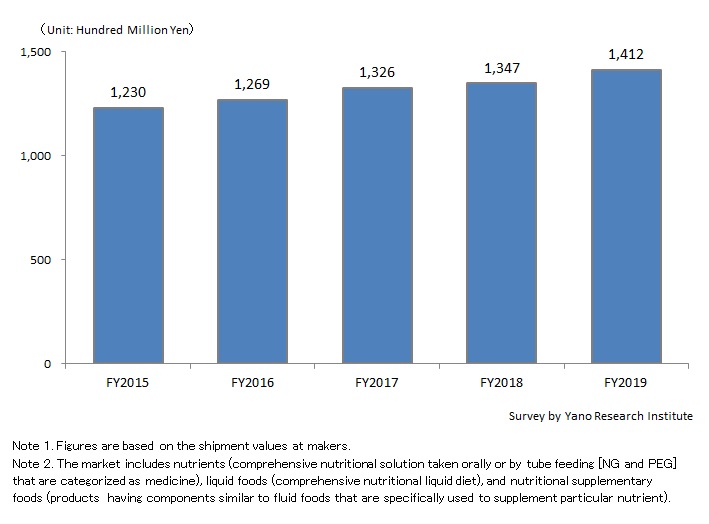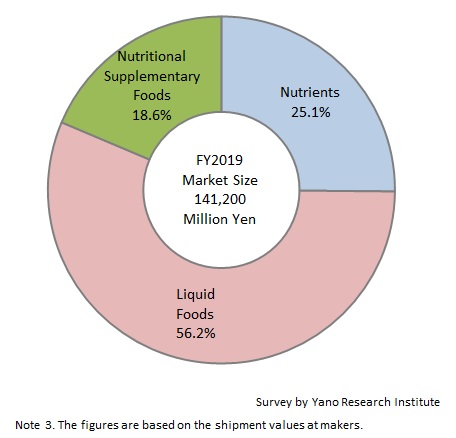No.2626
Nutrients, Liquid Food, and Nutritional Supplementary Food Market in Japan: Key Research Findings 2020
Nutrients, Liquid Food, and Nutritional Supplementary Food Market Size for FY2019 Rose by 4.8% to Attain 141.2 Billion Yen
Yano Research Institute (the President, Takashi Mizukoshi) has conducted a survey on the domestic market of nutrients, liquid foods, and nutritional supplementary food, and has found out the market size, the product trends, the trends at market plyers, and the future perspectives.


Market Overview
The market size of nutrients, liquid foods, and nutritional supplementary food (based on the shipment values at the makers) for FY2019 attained 141.2 billion yen, 104.8% of the size of the previous fiscal year. Of the total market size in FY2019, the ratio of liquid foods occupied the largest at 56.2% (79.4 billion yen, 104.0% YoY), nutrients accounted for 25.1% (35.5 billion yen, 105.3% YoY), and nutritional supplementary foods accounted for 18.6% (26.3 billion yen, 106.5% YoY).
When observing the trends per category, the demand for nutrients for homecare is increasing in particular. One of the reasons is that they are categorized as medicines covered by insurance, and the other is a risk involved in homecare, where high-calorie drips to central veins may be infused at the time of intravenous infusion. Demand for liquid food is also increasing at hospitals and elderly facilities because they bring about profit to the hospitals and elderly facilities when the receipts are balanced against the expenses for meals during hospitalization. In addition, nutritional supplementary food has stable demand as a way of preventing undernutrition of elderly. Against the background of a rise in senior population and government policy promoting health and longevity, the market continues expansion.
Noteworthy Topics
Manufacturers of nutrients, liquid foods, and nutritional supplementary foods are developing a wide variety of products. By application, the manufacturers develop products for specific medical condition such as kidney failure, hepatic impairment, immune deficiency, and chronic respiratory failure, as well as products for patients that had undergone PEG (Percutaneous Endoscopic Gastrostomy) procedure. By package, they developed soft (squeeze) bags and other various container types. Progress is also witnessed in the product development to meet the needs for additional micronutrients and dietary fiber, better taste, and modified texture. Moreover, they are expanding the product range by adding more formats, such as those that can be eaten as smaller meals or nutritious snacks ("complementary food"), those with higher calories, and those in powders that can be prepared as drinks by diluting with water to the required consistency.
Moreover, the makers are taking various measures to promote the sales, including building of a support system involving qualified nutritionists, enhancement of the sales promotions to NST (Nutrition Support Team), the distribution measures that assumes to supply nutrition to healthy people as well as for the home care market (increasing distribution of supplies to drugstores, utilization of in-house websites and specific online sales channels, alliances with home-care medical service providers/food delivery service providers/medicine wholesalers/medical-use food wholesalers).
As the competition of sales among the makers has become ever fiercer, the market share gap by product has expanded further, which led the market being dominated by a small number of large makers. As a result, some makers withdrew from the market or transferred the business to other companies aiming to concentrate on their strong area. Meanwhile, the dietary supplements, liquid foods, and nutritional supplementary food market is at the fluctuating period, as more companies entering the market and as more products being revised and abolished.
Future Outlook
As long as the insurance coverage continues and application of DCP/PDPS remains or develops at hospitals, the shift of demand for nutrients from hospitals to home care is likely to continue. Increasing number of the elderly at home indicates the increase of the non-healthy elderly, which is somewhat advantageous for the nutrient market. To the contrary, however, the NHI price revision can be a negative factor, because it does not bring about the growth in sales value, though sales volume may continue. NHI price has been revised at the time of consumer tax hike in October 2019, followed by another revision in April 2020. The market is projected to show a slight increase with more revisions hereafter.
The liquid foods market has been showing slight increase, and the annual growth rate for years to come is likely to be at around 1 to 2%. It seems that the growth can be expected for products such as those solid types, supplementary food types, those for the people undernutrition, those with high calories or high proteins, and those for oral administration. While supplements in fluid type decreases sharply, increase in sales from emerging new products is likely to cover the decline.
The nutritional supplementary food market is expected to continue stable growth at an annual rate around 2 to 3% going forward. Demand continues to grow for supplement in the form of snacks and desserts for the occupants of elderly facilities to prevent undernutrition, and for elderlies at home (not only healthy seniors but also those in pre-symptomatic state, i.e., having no serious illness but has a persistent feeling of indisposition).
Research Outline
2.Research Object: Makers of nutrients, liquid foods, and nutritional supplementary foods
3.Research Methogology: Face-to-face interviews by the expert researchers, surveys via telephone, and literature research
What are Nutrients, Liquid Foods, and Nutritional Supplementary Food?
In this research, the nutrient refers to the comprehensive nutritional solution taken orally or by tube feeding (nasogastric [NG] tubes or endoscopic gastrostomy [PEG] tubes), which is categorized as medicine. The liquid food refers to the comprehensive nutritional food with well-balanced nutrients (energy, three largest nutrients [protein, carbohydrate, and fat], minerals, and vitamins) in the form of liquid, semi-solid or solid (jelly), including liquid foods (thickened liquids) prescribed by healthcare professionals to fulfill the needs of patient’s medical conditions. The nutritional supplementary food indicates the foods that are close to fluid foods by components but not categorized as comprehensive nutritional foods. Such foods include those that are taken by elderly persons as complementary foods and the food for supplementation of a particular nutrient. The market size is calculated based on the shipment value at manufacturers.
<Products and Services in the Market>
Nutrients, Liquid Foods, and Nutritional Supplementary Foods
Published Report
Contact Us
The copyright and all other rights pertaining to this report belong to Yano Research Institute.
Please contact our PR team when quoting the report contents for the purpose other than media coverage.
Depending on the purpose of using our report, we may ask you to present your sentences for confirmation beforehand.